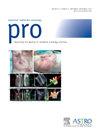针对早期乳腺癌的第一阶段 5 分次立体定向部分乳腺放射治疗方案的经济毒性和生活质量结果。
IF 3.4
3区 医学
Q2 ONCOLOGY
引用次数: 0
摘要
目的:我们报告了针对早期乳腺癌的 5 分次立体定向乳腺部分照射(S-PBI)前瞻性 1 期剂量递增研究的经济毒性和生活质量结果:单灶原位或浸润性上皮组织学,临床分期为0、I或II期,肿瘤大小小于3厘米,接受过肿块切除术治疗的女性参加了我们的1期5分次S-PBI剂量递增试验。在随访时,我们对接受治疗的患者进行了由本院编制的 "患者视角下的医疗成本和便利性 "问卷调查和EuroQol 5维度5级问卷调查:2010年至2015年期间,在75名参加试验并完成治疗的患者中,有68人至少完成了EuroQol 5维5级问卷或 "患者眼中的医疗成本和便利性 "问卷的部分内容。几乎所有患者都表示对治疗的总体满意度非常高,尤其是缩短了治疗时间。尽管治疗时间大大缩短,但仍有一半以上的患者表示存在一定程度的经济毒性(FT)。报告有经济负担的患者明显比没有治疗经济负担的患者年轻(平均值分别为 59.2 和 63.7,P = .03)。报告有任何经济负担的患者在种族、民族、婚姻或就业状况方面没有差异。在为期4年的随访中,这种S-PBI疗法对生活质量没有明显影响:这些患者报告的结果表明,在乳腺癌治疗中使用加速乳腺部分照射可能会降低FT率,尤其是对弱势患者群体而言。本文章由计算机程序翻译,如有差异,请以英文原文为准。
Financial Toxicity and Quality-of-Life Outcomes on a Phase 1 5-fraction Stereotactic Partial Breast Irradiation Protocol for Early-Stage Breast Cancer
Purpose
We report the financial toxicity and quality-of-life outcomes of our prospective phase 1 dose-escalation study of 5-fraction stereotactic partial breast irradiation (S-PBI) for early-stage breast cancer.
Materials and Methods
Women with unifocal in situ or invasive epithelial histologies, clinical stages 0, I, or II with tumor size < 3 cm treated with lumpectomy were enrolled in our phase 1 5-fraction S-PBI dose-escalation trial. Our institutionally generated questionnaire on the “Patient Perspective Cost and Convenience of Care” and the EuroQol 5-Dimension 5-level questionnaire were administered to patients treated at follow-up.
Results
Between 2010 and 2015, 68 of the 75 patients who enrolled and completed treatment on trial completed at least some component of either the EuroQol 5-Dimension 5-level questionnaire or the “Patient Perspective Cost and Convenience of Care” questionnaire. Nearly all patients reported very high satisfaction with their treatment overall, particularly the shortened length of treatment. Over half of the patients reported some level of financial toxicity (FT) despite a significantly shortened treatment time. Patients who reported any FT were significantly younger than patients with no financial burden of treatment (means 59.2 and 63.7, respectively, P = .03). There was no difference in those who reported any level of FT based on patient race, ethnicity, marital, or employment status. This S-PBI regimen did not significantly affect quality of life over a 4-year follow-up.
Conclusions
These patient-reported outcomes suggest that the use of accelerated partial breast irradiation may offer low FT rates in breast cancer care, particularly for disadvantaged patient groups.
求助全文
通过发布文献求助,成功后即可免费获取论文全文。
去求助
来源期刊

Practical Radiation Oncology
Medicine-Radiology, Nuclear Medicine and Imaging
CiteScore
5.20
自引率
6.10%
发文量
177
审稿时长
34 days
期刊介绍:
The overarching mission of Practical Radiation Oncology is to improve the quality of radiation oncology practice. PRO''s purpose is to document the state of current practice, providing background for those in training and continuing education for practitioners, through discussion and illustration of new techniques, evaluation of current practices, and publication of case reports. PRO strives to provide its readers content that emphasizes knowledge "with a purpose." The content of PRO includes:
Original articles focusing on patient safety, quality measurement, or quality improvement initiatives
Original articles focusing on imaging, contouring, target delineation, simulation, treatment planning, immobilization, organ motion, and other practical issues
ASTRO guidelines, position papers, and consensus statements
Essays that highlight enriching personal experiences in caring for cancer patients and their families.
 求助内容:
求助内容: 应助结果提醒方式:
应助结果提醒方式:


